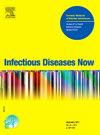Appropriateness of piperacillin-tazobactam prescriptions: a prospective multicentre study
IF 2.2
4区 医学
Q2 INFECTIOUS DISEASES
引用次数: 0
Abstract
Introduction
Our aim was to determine the reasons for appropriate Piperacillin-tazobactam (Pip-Taz) prescriptions.
Method
This was a prospective multicentre study of two-month Pip-Taz prescription in France. Reading of patient charts allowed for classification of diagnoses as definitive, suspected or unknown. Appropriateness of Pip-Taz was defined according to eight indications: post-operative infection in digestive surgery or urology, fever in onco-hematological patients, healthcare-associated infections (HCAI) in intensive care units, polymicrobial HCAI, infection due to multidrug-resistant bacteria, avoidance of carbapenem use, pulmonary infection in patients with chronic pulmonary disease, and following an internal guideline. Antibiotic reassessment was defined by any modification of Pip-Taz. Risk factors for erroneous Pip-Taz prescription were identified through a multivariate analysis, and participating physicians were interrogated on the subject.
Results
From April to July 2024, 259 prescriptions from 14 institutions were included. The diagnosis of infection was definitive in 127 cases (49 %), suspected in 97 (37 %), and unknown in 37 (14 %). Prescriptions were deemed appropriate in 204 cases (79 %). In logistic regression, appropriate Pip-Taz prescription was associated with definitive diagnoses, HCAI, microbiological investigations, advice by infectious disease specialists, and antibiotic reassessment (all adjusted OR ≥ 2.19). All in all, 37/55 prescriptions outside the scope of guidelines were elucidated by the prescribers, the main reason for them being “out of habit” (13/37), and we found a relationship between “unknown diagnosis” and no explanation for Pip-Taz prescription (p < 0.001).
Conclusion
Pip-Taz appropriateness was associated with correct management, i.e. written diagnosis, microbiological investigation, and reassessment, while prescriptions outside guidelines were related to physician habits, including no written diagnosis.
哌拉西林-他唑巴坦处方的适宜性:一项前瞻性多中心研究
我们的目的是确定哌拉西林-他唑巴坦(Piperacillin-tazobactam, Pip-Taz)处方合适的原因。方法在法国进行为期2个月的Pip-Taz处方的前瞻性多中心研究。阅读病人病历,将诊断分类为确定的、怀疑的或未知的。Pip-Taz的适宜性根据8个适应症来定义:消化外科或泌尿外科手术后感染、肿瘤合并血液学患者发热、重症监护病房卫生保健相关感染(HCAI)、多微生物感染、多药耐药菌感染、避免碳青霉烯类药物的使用、慢性肺部疾病患者肺部感染,以及遵循内部指南。抗生素的重新评估是由Pip-Taz的任何修饰来定义的。通过多变量分析确定Pip-Taz处方错误的危险因素,并就该主题询问参与的医生。结果2024年4 - 7月,共纳入14家机构的处方259张。感染确诊127例(49%),疑似97例(37%),未知37例(14%)。204例(79%)认为处方是适当的。在logistic回归中,适当的Pip-Taz处方与明确诊断、HCAI、微生物学调查、传染病专家建议和抗生素重新评估相关(所有调整后的OR≥2.19)。总而言之,指南范围外的处方中有37/55是由处方者解释的,主要原因是“出于习惯”(13/37),我们发现“未知诊断”与Pip-Taz处方无解释之间存在关系(p <;0.001)。结论pip - taz的适宜性与正确的管理有关,包括书面诊断、微生物调查和再评估,而处方不符合指南与医生习惯有关,包括没有书面诊断。
本文章由计算机程序翻译,如有差异,请以英文原文为准。
求助全文
约1分钟内获得全文
求助全文
来源期刊

Infectious diseases now
Medicine-Infectious Diseases
CiteScore
7.10
自引率
2.90%
发文量
116
审稿时长
40 days
 求助内容:
求助内容: 应助结果提醒方式:
应助结果提醒方式:


